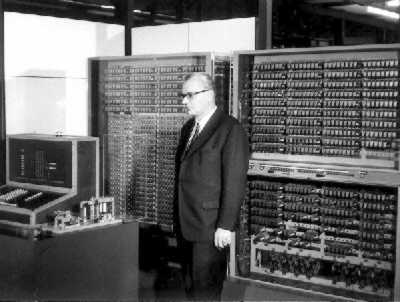| Konrad Zuse and the First Working Computers |
| Written by Historian | |||||||
Page 3 of 3
Preserved For PosterityIn the closing stages of the war Zuse's machines were destroyed by bombing - except for the Z4. After the battle of Stalingrad, Zuse was convinced that the war was lost and he packed up the Z4 and tried to find somewhere safe for it. He transported it south across Germany in the company of Werner Von Braun and his fellow rocket scientists. The idea was that it was better to be captured by the Americans than the Russians. He had been ordered to store the machine at Northeim, but after seeing the concentration camps he decided to move on. Zuse managed to find a comfortable hiding place in the alpine village of Hinterstein. The Z4 was placed in a cellar among the apple barrels and all was well until the villagers became convinced that it was another of Hitler's secret weapons. The Allied authorities got to know about it and Zuse was arrested and questioned. It didn't take long to establish that he and the Z4 were innocent. The Z4 eventually found its way to Zurich where Zuse was living in 1950. It was acquired by Eduard Stiefel, the mathematician who headed the Institute for Applied Mathematics at ETH Zurich, which had been founded in 1948. There it was overhalued and expanded and was in operation from 1950 to 1955 - the only significant computer on the European mainland at the time.
Today the original Z4 is housed the Deutsches Museum in Munich, beautifully displayed but not operational. Perhaps this might change thanks to the fact that its operating manual, probably authored by Zuse himself has been unearthed. It was found by archivist Evelyn Boesch from the ETH Zurich among rare historical documents kept by her own father René Boesch. Born in 1929, Boesch worked at the Institute for Aircraft Statics and Aircraft Construction at ETH Zurich, a department that ran around 100 jobs on the Z4 during its period of operation there. The manual had been revised to include details of how to perform conditional jumping, a facility the Z4 did not have originally, but was added at the request of ETH Zurich. Plankalkül - First Programming LanguageAfter the war Zuse hoped to taken on by IBM or some large US, or even UK, computer company. However although the US wanted the German rocket scientists, it didn't seem to need computer pioneers. He spent some time negotiating with IBM, but all they wanted to buy were the patents on the existing machines and not any new research. His long time friend Schreyer went off to South America to become a successful business man. Zuse remained in the German alps working on a new programming language, Plankalkül, Plan Calculus or "formal system for planning". The post war years weren't suitable for hardware development and so software became a more feasible endeavour. Plankalkül was a general purpose language for computation but no-one seemed interested in it. Zuse set up a company in 1949, Zuse KG, which grew to employing 1000 people building specialist scientific computers. He stayed with the company until 1966 when he retired to a little consulting and a lot of painting - his lifelong hobby. The company was eventually taken over by Siemens.
Zuse with the Z3 Konrad Zuse and the Z series of computers stand alone in the history of computing. It is interesting to speculate what difference support from the German government might have made, but with hindsight it is undoubtedly better that they overlooked this potential aid to warfare. In contrast to the US, and even the UK, where there was funding for computing and teams created the early machines, Zuse worked alone and virtually unsupported. This makes his achievement all the more amazing.
The story of why and how Zuse designed his first three computers is the topic of this video posted on You Tube in 2020 by the Computer History Archives Project ("CHAP"). It is an excerpt from "The Machine that Changed the World," a 5-episode television series on the history of electronic digital computers from WGBH which aired in 1992 and includes conversations with Zuse himself:
Further Information There is a page devoted to Konrad Zuse on the website maintained by his son Horst Zuse. It has biographical details, a photo archive and and gives access to a tour through all the Zeus computers in German and English. There are two museums devoted to Konrad Zuse. Konrad-Zuse-Museum is the website of the museum in Hünfeld Germany where Zuse lived from 1957, while the other is in Hoyerswerda where he lived with his parents from 1923 to 1928. Related ArticlesKonrad Zuse Born On This Day In 1910 Sergei Lebedev and Early Russian computers To be informed about new articles on I Programmer, sign up for our weekly newsletter, subscribe to the RSS feed and follow us on Twitter, Facebook or Linkedin.
Comments
or email your comment to: comments@i-programmer.info
|
|||||||
| Last Updated ( Sunday, 22 June 2025 ) |





